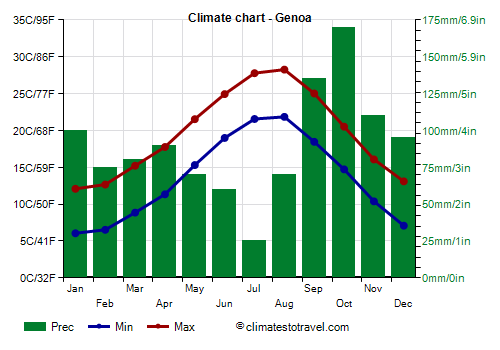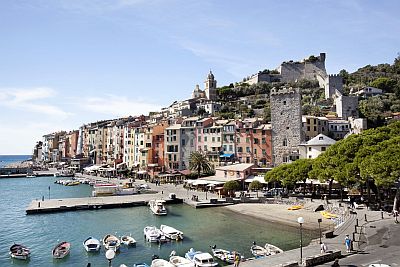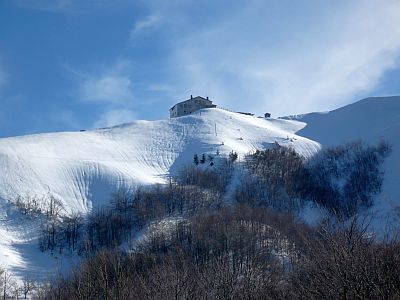Select units of measurement for the temperature and rainfall tables (metric or imperial).
Average weather, temperature, rainfall, sunshine hours
In Liguria, a region in northwestern Italy, the climate is
Mediterranean on the coast, with mild, rainy winters and warm to hot, sunny summers.
In the inland areas, occupied almost entirely by hills and mountains, the climate becomes colder as one moves away from the sea and climbs in altitude.
Coast and hills
As mentioned, on the
coast of Liguria, there is a
Mediterranean climate.
Winter is mild, but there can be quite cold and windy periods, and although snow is rare, it can occasionally snow, especially at the mouth of the valleys, where the cold air can be channeled between the mountains (see Savona, Genoa, La Spezia).
Summer is not as hot as in the rest of Italy, however, there can be sultry periods, and more rarely, when the wind comes down from the mountains, very hot and dry days, with highs of 35 °C (95 °F) or more.
The amount of
sunshine is good, however, between December and April, cloud cover can sometimes form, in periods of high pressure.
To the west, the
Riviera di Ponente, especially the part west of Savona (see Ventimiglia, Bordighera,
Sanremo,
Imperia, Albenga), protected by the Ligurian Alps, is particularly mild, and has characteristics that they are found only in southern Italy: the average January temperature exceeds 10 °C (50 °F), frosts are very rare, and there are on average 2,500 hours of sunshine a year. Also, in the summer, it's usually not too hot. Precipitation is not abundant and amounts to about 700 millimeters (27.5 inches) a year.
In the
central-eastern part of the coast (see Genoa, Chiavari, Cinque Terre,
La Spezia), the climate is still mild, however, the winter is slightly colder. Furthermore, the climate is more rainy, in fact rainfall amounts to 1,000/1,200 mm (40/47 in) a year, and at times, especially in autumn, there can be very abundant rains, which can generate floods.

In
Genoa, the capital of the region, located in the central part of the coast, the average temperature in January is about 9 °C (48 °F), that of July and August is 25 °C (77 °F). Here are the average temperatures.
Genoa - Average temperatures (1991-2020) |
| Month | Min | Max | Mean |
|---|
| January | 6.1 | 12.1 | 9.1 |
|---|
| February | 6.5 | 12.7 | 9.6 |
|---|
| March | 8.9 | 15.2 | 12 |
|---|
| April | 11.4 | 17.8 | 14.6 |
|---|
| May | 15.3 | 21.5 | 18.4 |
|---|
| June | 19 | 24.9 | 22 |
|---|
| July | 21.6 | 27.8 | 24.7 |
|---|
| August | 21.8 | 28.3 | 25.1 |
|---|
| September | 18.5 | 25 | 21.7 |
|---|
| October | 14.7 | 20.5 | 17.6 |
|---|
| November | 10.4 | 16.1 | 13.2 |
|---|
| December | 7.1 | 13.1 | 10.1 |
|---|
| Year | 13.5 | 19.6 | 16.5 |
|---|
On average, around 1,000 mm (40 in) of rain fall per year.
Genoa - Average precipitation| Month | Days |
|---|
| January | 100 | 8 |
|---|
| February | 75 | 6 |
|---|
| March | 80 | 7 |
|---|
| April | 90 | 8 |
|---|
| May | 70 | 7 |
|---|
| June | 60 | 5 |
|---|
| July | 25 | 3 |
|---|
| August | 70 | 5 |
|---|
| September | 135 | 6 |
|---|
| October | 170 | 8 |
|---|
| November | 110 | 7 |
|---|
| December | 95 | 7 |
|---|
| Year | 1080 | 77 |
|---|
The
sea in Liguria is warm enough for swimming in July and August. In June, the Ligurian Sea is still cool. In the Riviera di Ponente, the sea is a little cooler than in that of the Levante, because it is partially affected by the cooling it undergoes in nearby France, where the sea is cooled by the mistral. In Genoa, the water temperature reaches 24 °C (75 °F) in July and 25 °C (77 °F) in August.
Genoa - Sea temperature| Month |
|---|
| January | 13.5 |
|---|
| February | 13 |
|---|
| March | 13.5 |
|---|
| April | 14.5 |
|---|
| May | 18 |
|---|
| June | 21.5 |
|---|
| July | 24 |
|---|
| August | 25 |
|---|
| September | 22.5 |
|---|
| October | 20 |
|---|
| November | 17"> |
|---|
| December | 14.5 |
|---|
| Year | 18.1 |
|---|

In the
interior, the climate becomes more continental. In the few valleys at plain altitudes (see Villanova d'Albenga, the Polcevera Valley north of Genoa and the Vara Valley near La Spezia), the temperature can drop below -5 °C (23 °F) in winter, while in summer it can exceed 35 °C (95 °F).
In
Sarzana, located in the easternmost part of Liguria (Lunigiana), the average temperature ranges from around 7.5 °C (45.5 °F) in January to 24.5 °C (76 °F) in July, with highs of 31 °C (88 °F).
Sarzana - Average temperatures (2003-2020) |
| Month | Min | Max | Mean |
|---|
| January | 2.7 | 12.3 | 7.5 |
|---|
| February | 3.2 | 13.4 | 8.3 |
|---|
| March | 5.2 | 15.8 | 10.5 |
|---|
| April | 8.2 | 20.4 | 14.3 |
|---|
| May | 11.7 | 24 | 17.8 |
|---|
| June | 15.5 | 28.3 | 21.9 |
|---|
| July | 17.8 | 31.3 | 24.5 |
|---|
| August | 17.4 | 31.1 | 24.2 |
|---|
| September | 14.4 | 27.4 | 20.9 |
|---|
| October | 11.1 | 22.3 | 16.7 |
|---|
| November | 7.4 | 17.3 | 12.3 |
|---|
| December | 3.7 | 13.4 | 8.6 |
|---|
| Year | 9.9 | 21.5 | 15.65 |
|---|
In the
hilly areas between the sea and the mountains, in winter, there may be snowfall and frost. Precipitation is more abundant, and amounts to about 1,000 mm (40 in) per year in the western part, while in the central-eastern part it often exceeds 1,500 mm (60 in), and can even exceed 2,000 mm (80 in) in some areas.
In
Cairo Montenotte, located in Val Bormida, in the province of Savona, at an altitude of 330 metres (1,080 ft), the average temperature ranges from 2.5 °C (36.5 °F) in January to 22.5 °C (72.5 °F) in July and August. Here, the temperature dropped to -12 °C (10.5 °F) in December 2009, while it reached 37 °C (98.5 °F) in late June 2019.
Cairo Montenotte - Average temperatures (2001-2020) |
| Month | Min | Max | Mean |
|---|
| January | -1.8 | 7.1 | 2.6 |
|---|
| February | -0.8 | 8.7 | 3.9 |
|---|
| March | 2.4 | 12.6 | 7.5 |
|---|
| April | 6.4 | 16.4 | 11.4 |
|---|
| May | 10.3 | 20.2 | 15.2 |
|---|
| June | 14.7 | 24.8 | 19.8 |
|---|
| July | 16.6 | 27.4 | 22 |
|---|
| August | 16.1 | 27.4 | 21.8 |
|---|
| September | 12.3 | 23.3 | 17.8 |
|---|
| October | 8.4 | 17.6 | 13 |
|---|
| November | 4.1 | 12 | 8 |
|---|
| December | -0.4 | 8 | 3.8 |
|---|
| Year | 7.4 | 17.2 | 12.25 |
|---|
Mountains
As mentioned, in the western part of the region are the
Ligurian Alps. The highest peaks exceed 2,500 metres (8,200 ft), but are located in Piedmont. The highest peak in Liguria is
Monte Saccarello, 2,200 meters (7,218 ft) high, located on the border with Piedmont.
At
Poggio Fearza, located at an altitude of 1,800 meters (5,900 ft) in the municipality of Mendatica, the average temperature ranges from -1 °C (30 °F) in January and February to 15 °C (59 °F) in July and August. Here, the temperature dropped to -16.5 °C (2.5 °F) in late February 2018, while it reached 29 °C (84 °F) in late June 2019.
Poggio Fearza - Average temperatures (2009-2020) |
| Month | Min | Max | Mean |
|---|
| January | -3.6 | 2.1 | -0.8 |
|---|
| February | -3.7 | 2 | -0.9 |
|---|
| March | -1.8 | 3.9 | 1.1 |
|---|
| April | 1.3 | 7.6 | 4.4 |
|---|
| May | 4.4 | 11 | 7.7 |
|---|
| June | 9 | 15.6 | 12.3 |
|---|
| July | 11.6 | 18.6 | 15.1 |
|---|
| August | 11.6 | 18.7 | 15.1 |
|---|
| September | 8 | 14.8 | 11.4 |
|---|
| October | 4.4 | 10.6 | 7.5 |
|---|
| November | 0.7 | 6.1 | 3.4 |
|---|
| December | -1.7 | 3.9 | 1.1 |
|---|
| Year | 3.4 | 9.6 | 6.5 |
|---|

The central-eastern part of the region is occupied by the
Ligurian Apennines, whose highest peak is Monte Maggiorasca, 1,804 meters (5,919 ft) high, on the border with Emilia-Romagna. In the area, there is also a ski lift, at Monte Bue - Santo Stefano d'Aveto.
Best Time
For a
beach holiday along the coast of Liguria, the best period is the summer, particularly in July and August, since they are the hottest and sunniest months, and in which the sea is warmest as well.
To
visit the cities, you can choose spring and early summer, in particular, from mid-April to mid-June. September, too, is a good month, especially in the first half, while later, Atlantic depressions become more frequent.
In the height of summer, in July and August, it can be hot, although less frequently than in other parts of Italy.
See also the
temperatures by month.